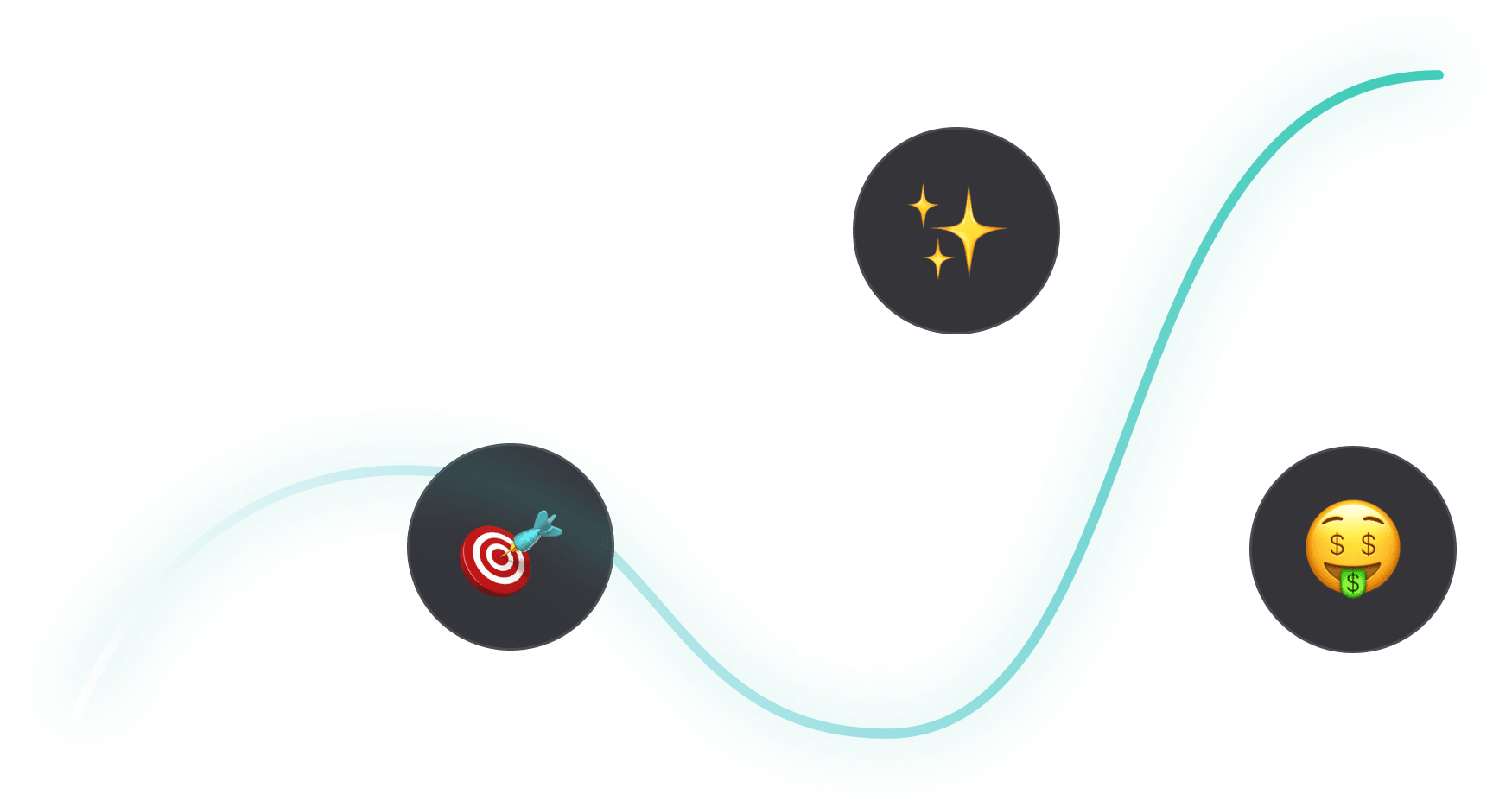
B2B
How to Track Form Submissions in Google Tag Manager?
I’ve spent a lot of time wrestling with tracking form submissions in Google Tag Manager (GTM), and I know how frustrating it can be when things just don’t work as expected.
Forms behave in all sorts of unpredictable ways. Some refresh the page, some stay put, and others redirect users to a "Thank You" page.
And because there’s no universal rule for how developers build forms, you and I need different tracking approaches depending on the situation.
And since chances are you’re using form submission to also track how your Google ad campaigns are converting, it becomes super critical for us to get this right.
That’s why in this guide, I’ll break down the most effective ways to track form submissions, step by step, so you don’t have to figure it all out the hard way like I did.
Understanding the Tag and Trigger Relationship in GTM
Before we dive into the methods, let’s quickly cover the basics. GTM relies on two key components:
- Tags: These send data to platforms like Google Analytics 4 (GA4).
- Triggers: These tell GTM when to fire a tag.
To track form submissions properly, you need:
- A GA4 event tag that sends a form submission event to GA4.
- A trigger that detects when a form is successfully submitted.
Step-by-Step: Creating a GA4 Event Tag
- Go to Tags in GTM and click New.
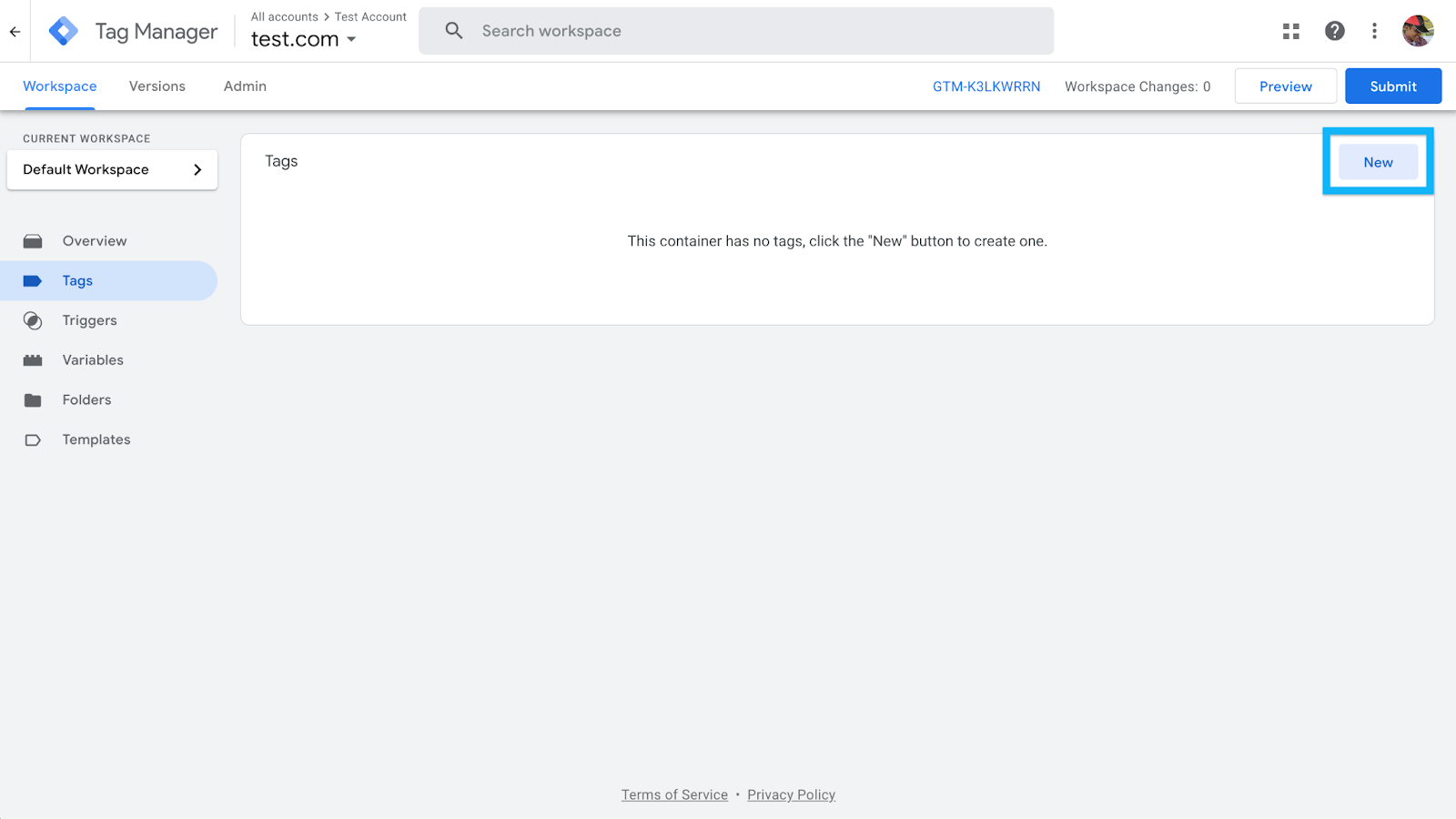
- In Tag Configuration, select Google Analytics: GA4 Event.
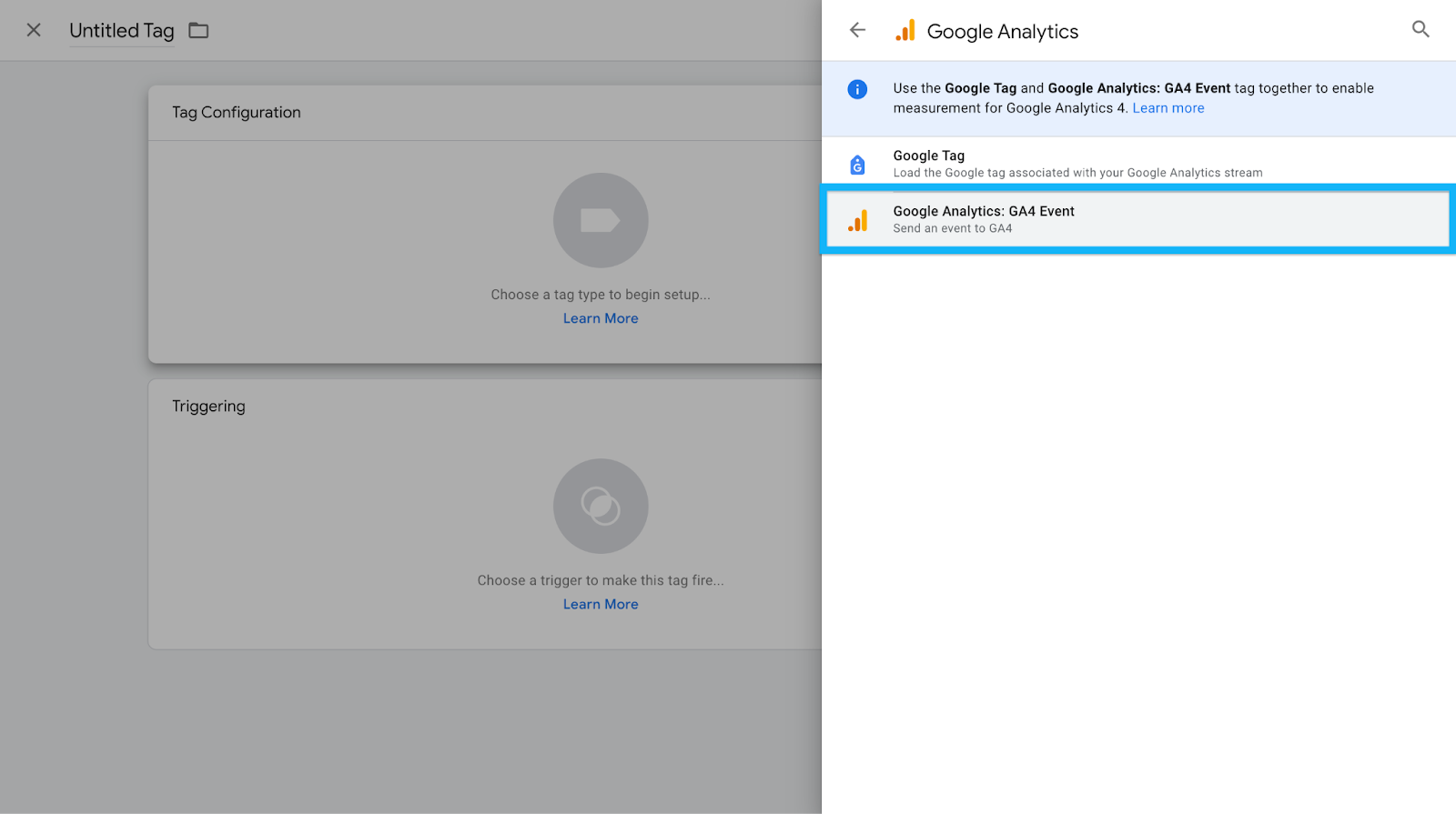
- In the Measurement ID field, insert your GA4 tracking ID (or use a Constant Variable if you’ve set one up).
- In the Event Name field, enter "generate_lead" (this is a recommended GA4 event, but you can change it if needed).

- Leave the Triggering section empty for now. We’ll configure that next.
- Click Save.
At this point, the tag exists but doesn’t do anything because there’s no trigger.
Now, let’s set that up based on how your form behaves.
Method 1: Track Form Submission Using GTM’s Built-in Form Submission Trigger
In an ideal world, GTM’s built-in Form Submission trigger would work for every form.
But in my experience, it rarely does. This trigger only works if the form fires a native submit event, which many modern forms (especially AJAX-based ones) don’t.
Step-by-Step: Configuring the Form Submission Trigger
- In GTM, go to Variables > Configure and enable all Form Variables (Form ID, Form Classes, Form Target, Form Text, etc.).
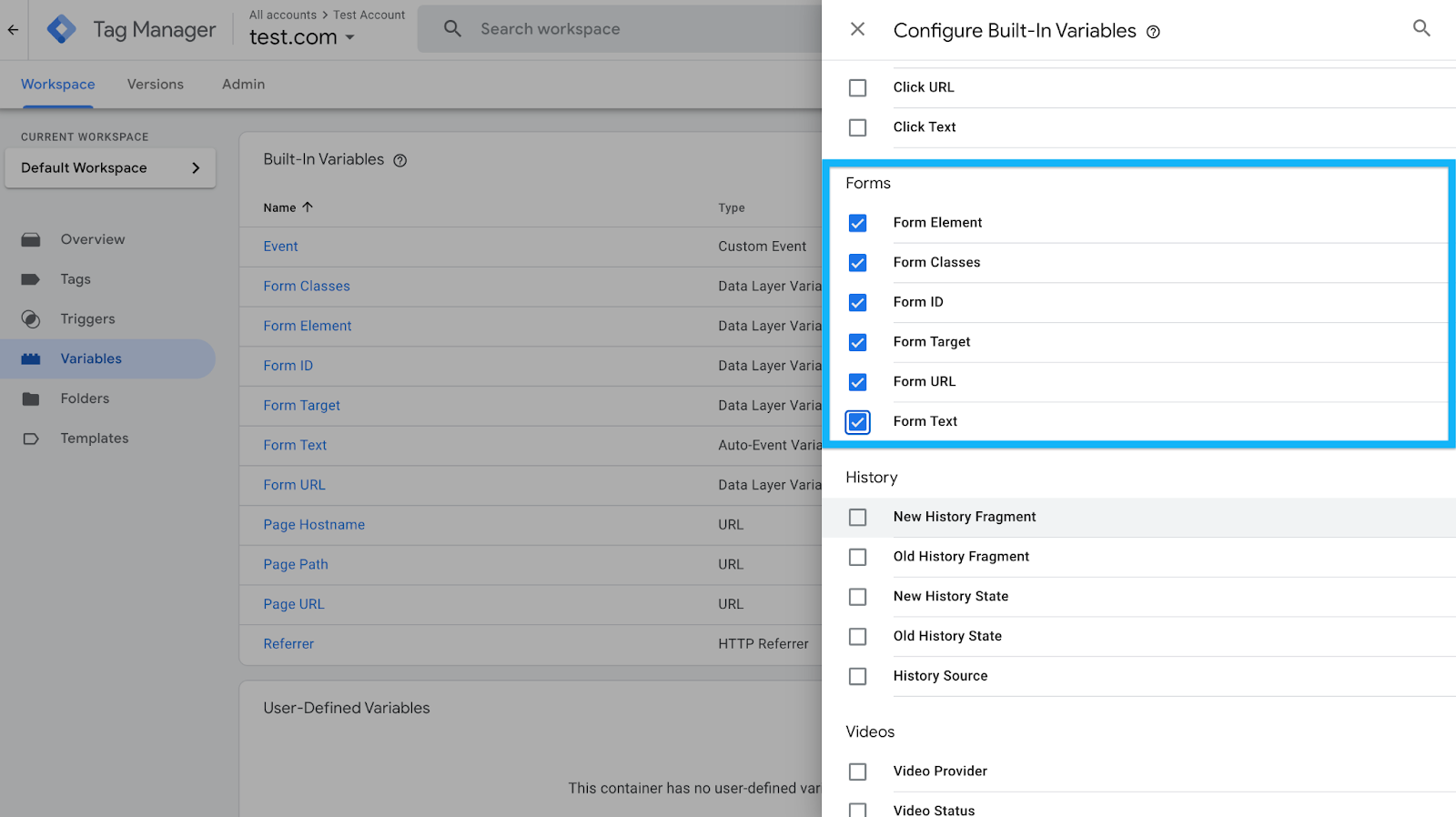
- Navigate to Triggers and create a new trigger:
- Choose Form Submission as the trigger type.
- Choose Form Submission as the trigger type.

- Check Wait for Tags and set a delay (e.g., 2000 milliseconds) to ensure tracking before the page redirects.
- Enable Check Validation to ensure only valid submissions are tracked.
- Under "Enable this trigger on…", set Page Path contains / so it works across the site.
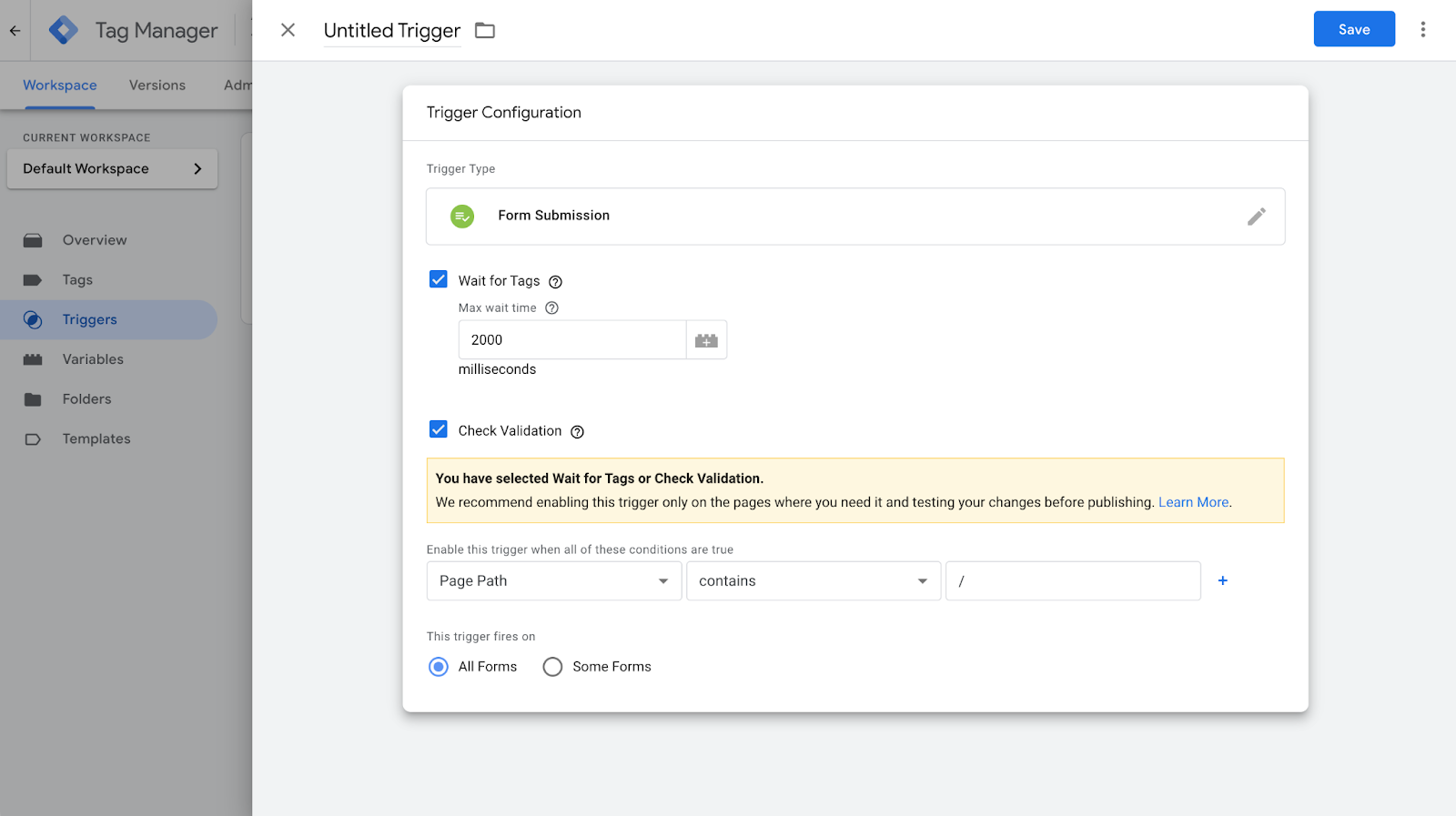
- Click Save.
Assigning the Trigger to the GA4 Event Tag
- Open the GA4 event tag.
- In the Triggering section, select the Form Submission trigger you just created.
- Click Save.
- Enable Preview Mode in GTM and test it by submitting a form.
- Check the GTM Debug Panel to see if a Form Submit event appears.
- If it appears, great! The trigger works.
- If it doesn’t, your form likely prevents the submit event. Move on to the next method.
- If it appears, great! The trigger works.
Method 2: Track Form Submissions via a "Thank You" Page
If your form redirects users to a confirmation page after submission, this is the easiest and most reliable tracking method.
The one mistake I see folks repeat often is they link to this thank you or add it in your sitemap.
The way this method works is it sends an event every time this page is loaded.
So you want to double check to ensure that people don’t land on this page through other sources.
Step-by-Step: Setting Up a Thank You Page Trigger
- In GTM, go to Triggers and create a new trigger.
- Choose Page View as the trigger type.
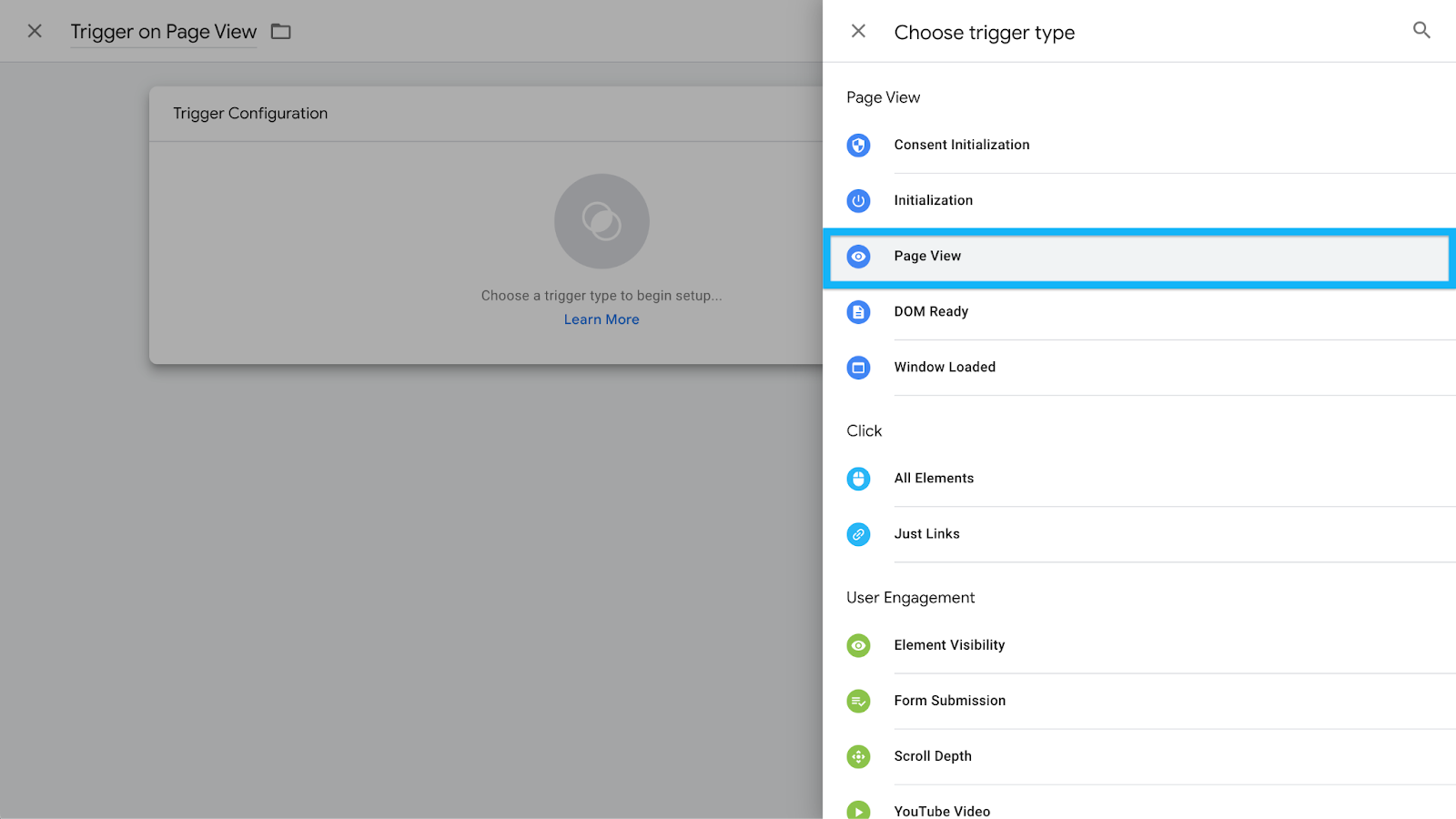
- Select Some Page Views and define the condition:
- If the URL is static (e.g., https://www.example.com/thank-you), set Page Path equals /thank-you.
- If the URL is dynamic, use Page URL contains thank-you (just make sure it’s unique).
- If the URL is static (e.g., https://www.example.com/thank-you), set Page Path equals /thank-you.
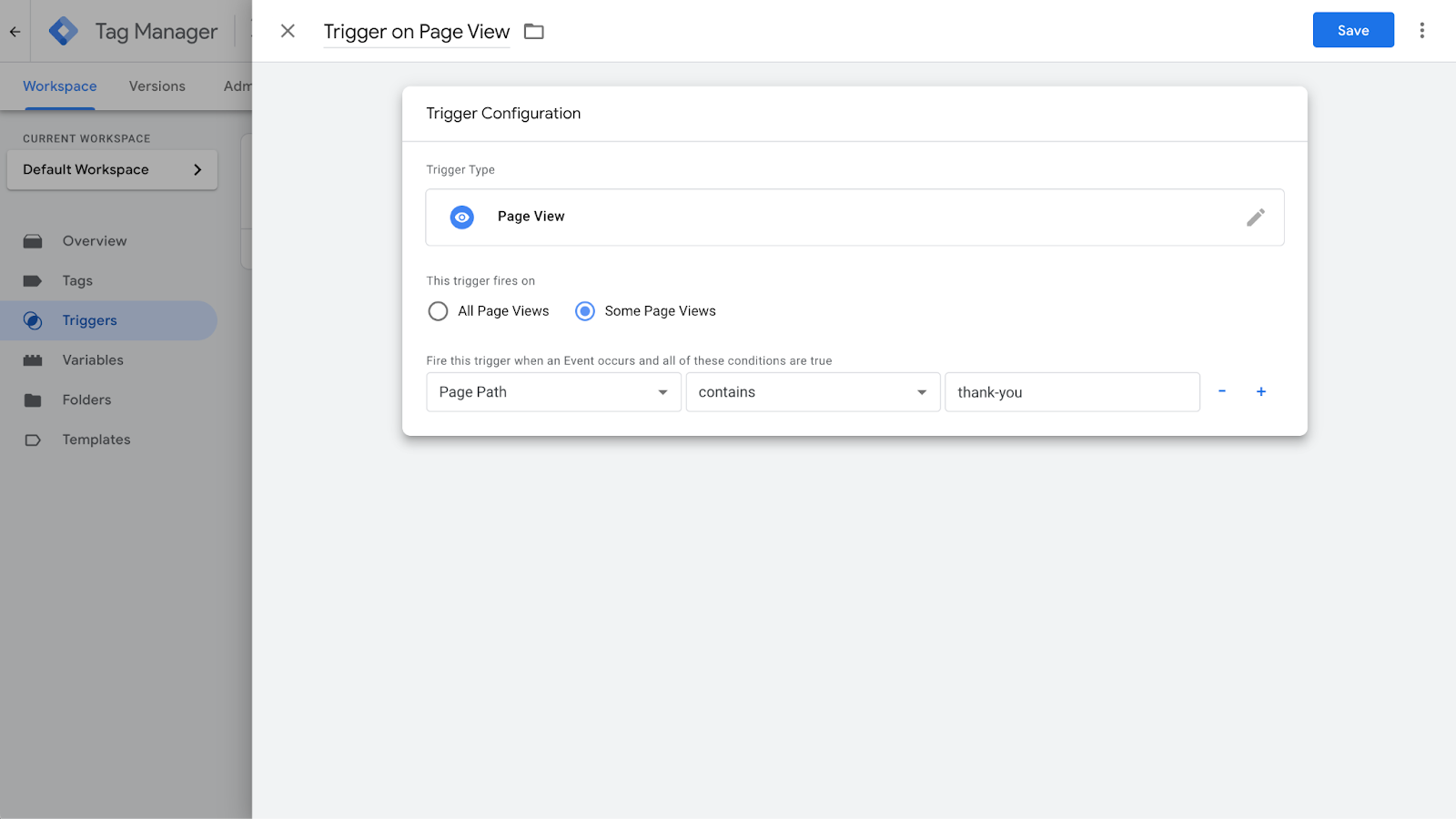
- Name the trigger something clear (e.g., "Pageview – Form Submission").
- Click Save.
Assigning the Trigger to the GA4 Event Tag
- Open the GA4 event tag.
- In the Triggering section, select the Thank You Page trigger.
- Click Save.
- Enable Preview Mode and test by submitting the form.
- Verify in GA4 Debug View that the event fires only when users reach the confirmation page.
This method is foolproof as long as users can’t access the "Thank You" page without actually submitting the form.
Enhancing Tracking with Custom Parameters
If you have multiple forms on your website, tracking just a generic "form submission" event isn’t enough.
You need to capture more details that help differentiate between each form submission, such as:
- Form ID: A unique identifier assigned to each form, which can be extracted using GTM’s built-in variables.
- Form Name: Some forms may not have an explicit ID, but they may have a specific name attribute that can be tracked.
- Page URL: If each form is located on a unique page (e.g., /contact-us vs. /signup), capturing the URL will help differentiate where the submission occurred.
- Form Type: If you have multiple lead capture forms (e.g., demo request, newsletter signup, contact form), you can categorize submissions based on the form's purpose.
Step-by-Step: Adding Custom Parameters to the GA4 Event Tag
- Enable Form Variables: Go to Variables > Configure, and enable all Form Variables (Form ID, Form Classes, Form Target, Form Text, etc.).
- Modify Your GA4 Event Tag:
- Open your GA4 event tag in GTM.
- In the Event Parameters section, click Add Row.
- Define custom parameters for form tracking:
- Parameter Name: form_id → Value: {{Form ID}}
- Parameter Name: form_name → Value: {{Form Name}}
- Parameter Name: page_path → Value: {{Page Path}}
- Parameter Name: form_id → Value: {{Form ID}}
- Open your GA4 event tag in GTM.
- Save and Test:
- Enable Preview Mode in GTM.
- Submit different forms on your site and check if the correct form details appear in the GTM Debug Panel.
- If the values are being captured correctly, publish the changes.
- Enable Preview Mode in GTM.
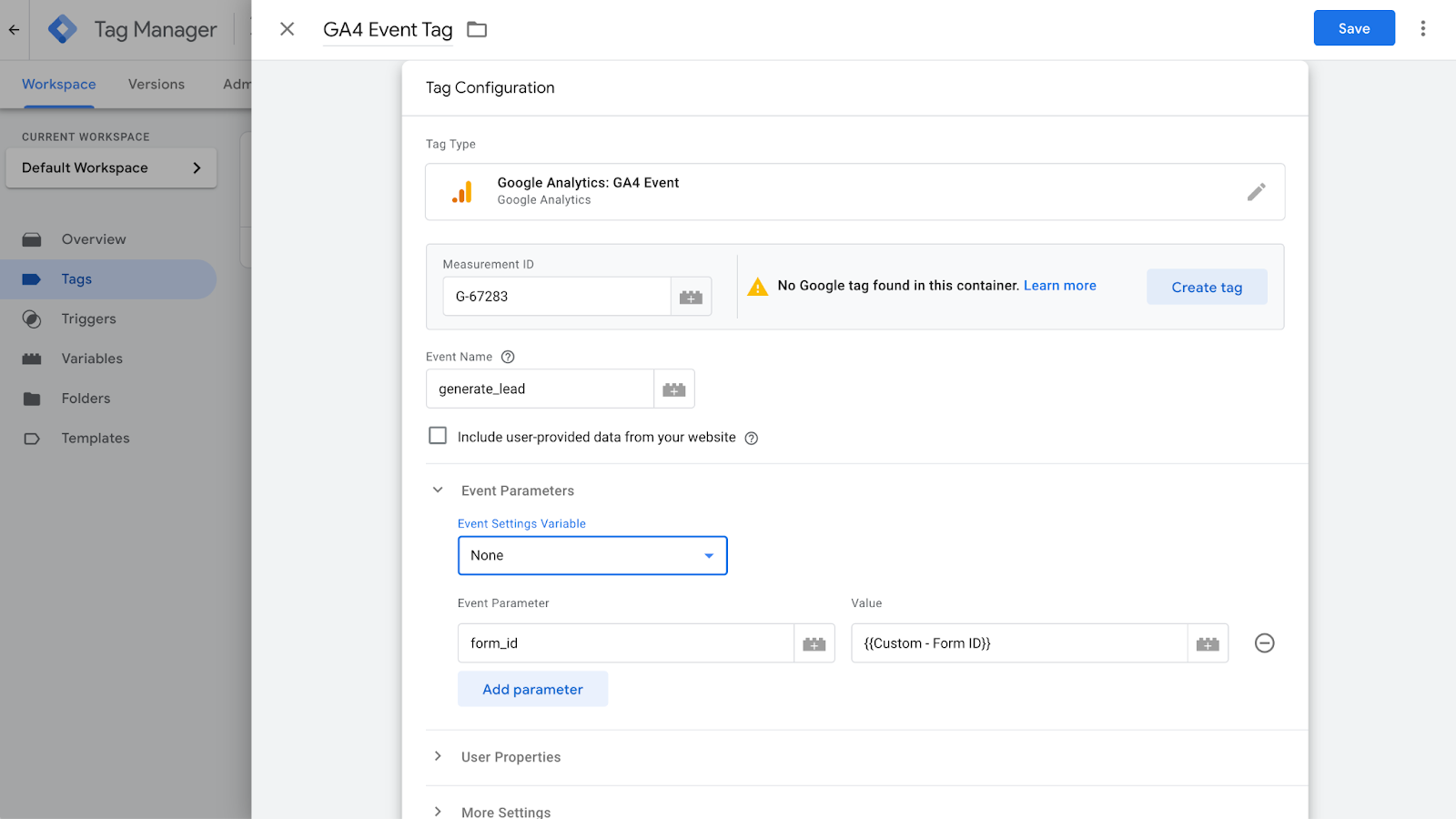
If you want to use this data in GA4 reports, you’ll need to register it as a Custom Dimension:
- In GA4, go to Admin > Custom Definitions.
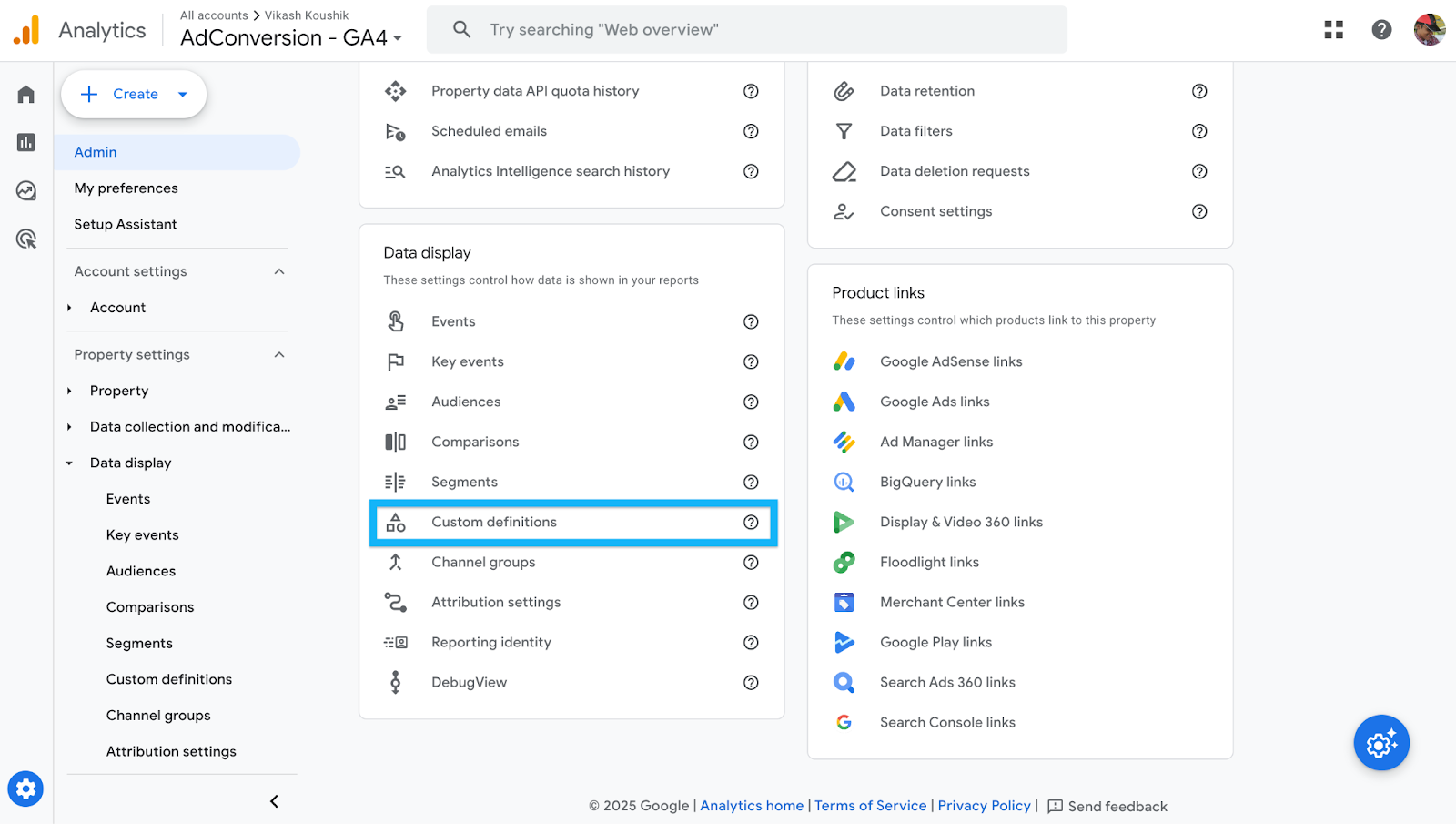
- Click Create Custom Dimension.
- Define each parameter:
- Name: Form ID → Event Parameter: form_id → Scope: Event
- Name: Form Name → Event Parameter: form_name → Scope: Event
- Name: Page Path → Event Parameter: page_path → Scope: Event
- Name: Form ID → Event Parameter: form_id → Scope: Event

- Click Save.
By implementing this setup, you ensure that every form submission is attributed to the right form, providing clearer insights into form performance, lead quality, and conversion attribution.
Conclusion
The right tracking method depends on how your form behaves:
- Use the Form Submission trigger if GTM’s listener detects the event.
- Use the Thank You page method if the form redirects after submission.
- Use click tracking for AJAX-based forms.
Test everything thoroughly in Preview Mode to ensure you’re capturing data correctly.
I’ve been through enough form tracking struggles to know that what works on one site may completely fail on another.
Hopefully, this guide saves you a lot of time and frustration!
If you’re looking to see what the paid media marketing pros are up to, you should come and hang with them in the community.
The community is where you can ask the questions you wouldn’t post on LinkedIn and get insights that you wouldn’t find on Google.
You get access to:
- Weekly experiments with real data: No guesswork, just tested strategies from real campaigns.
- Templates & playbooks: Proven frameworks to streamline our processes and improve efficiency.
- Masterminds & expert discussions: Stay ahead of strategies, tactics, and ad platform changes instead of reacting late.
- Benchmarking against top B2B advertisers: Learn what’s working for others running high-budget campaigns.
Come, sign up and see what the pros are talking about in the community. It takes less than a minute to sign up.
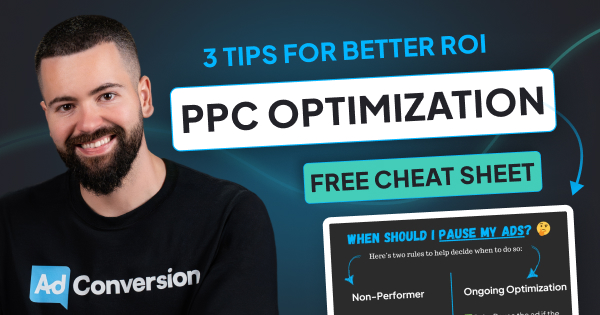
3 Simple B2B PPC Optimization Tips For Better ROI [+Free Cheat Sheet]
Hey B2B marketer! Without clearly defined rules for testing and optimizing your PPC campaigns, you’re either going to pause things prematurely, or you’re going to scale too early.
In this article, you’ll learn how to make decisions based on logic instead of emotions when managing your PPC campaigns.
Let’s dive in! 👇
TABLE OF CONTENTS
- 1 - Find Your Breakeven Costs
- 2 - Non-Performer Rule
- 3 - Maintenance Rule
- 4 - Free PPC Optimization Cheat Sheet
- 5 - Free Resources to Build a Full-Funnel Paid Media Program
1 - Find Your Breakeven Costs
Your goal is to drive more pipeline and revenue, so knowing how much you can afford to spend per lead or click is the first step to ensure you don’t lose money while optimizing for performance.
Breakeven Cost per Lead
Here’s what you will need to calculate your breakeven cost per lead:
- Take your average deal size
- Multiply that towards your lead to close won rate.
Example:
If your deal size is $3,000 and your close rate is 10%, your breakeven cost per lead is $300.
This means that when optimizing your ppc campaigns, you can spend up to $300 to break even. So you’ll start to lose money if anything goes after $300.

Breakeven Cost per Click
This is a step further and will inform what you’re willing to pay the channel for a click.
Here’s what you will need to calculate your breakeven cost per click:
- Take the breakeven cost per lead target
- Multiply that towards your landing page or form conversion rate if you use lead gen forms.
Example:
If your breakeven cost per lead is $300 and your landing page/form conversion rate is 5%, your breakeven cost per click is $15.

This foundational math grounds your optimization decisions and eliminates emotional bias, ensuring you stay within profitable bounds.
2 - Apply a Non-Performer Rule
When ads fail to deliver results, emotions often lead us to either pause campaigns too soon or let them run too long.
This is where the non-performer rule saves the day.
The rule is simple:
- Pause any ad that spends 2-3x your target cost per lead without generating conversions.
- Timeframe: All time.
Example:
If your target is $300 per lead and you spend $600-$900 without results, it’s time to hit pause.
This removes emotional bias and gives your ads a fair shot before deciding their fate.
By doing this, you stop wasting money and gain clarity on what isn’t working, allowing you to allocate your budget more effectively.
3 - Apply a Maintenance Rule
Even great ads don’t perform forever. Over time, performance may drop due to ad fatigue or other factors.
The maintenance rule will help you handle these scenarios with logic, not guesswork.
Here’s how it works:
- If an ad’s cost per lead increases to 1.5-2x your target over a 7-14-day period, it’s time to pause.
Example:
If your cost per lead target is $300, an ad costing $450-$600 per lead is no longer viable, and you should pause it.
Free B2B PPC Optimization Rules Cheat Sheet
Save this cheat sheet below to have these rules on hand when optimizing your B2B PPC campaigns. 🙂
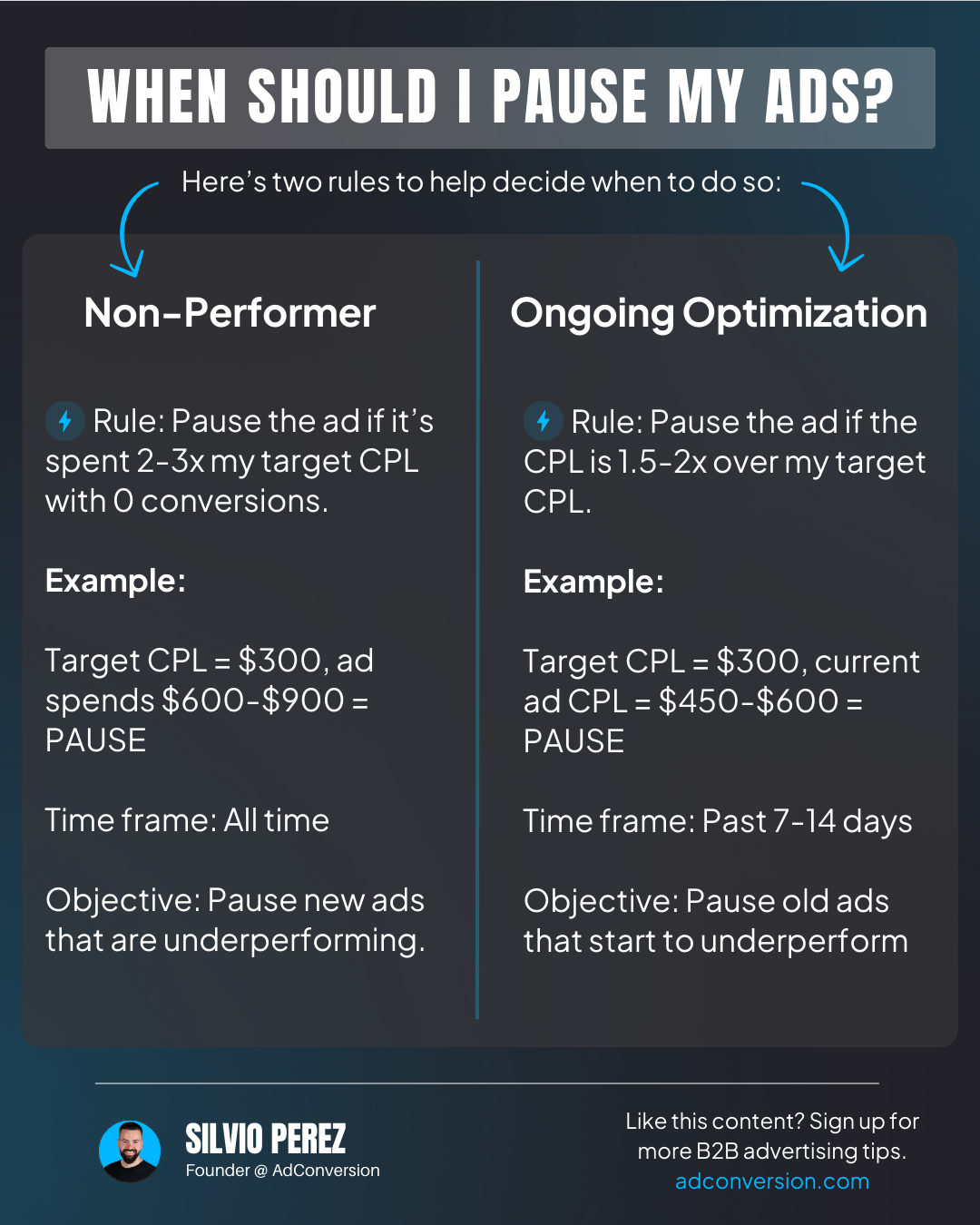
This isn’t statistically significant, but it’s an easy approach grounded in logic that helps to remove emotion.
Remember: The best advertisers think like investors, and they execute like scientists, so rational thinking is key.
By calculating breakeven costs, applying the non-performer rule, and using the maintenance rule, you can make logical, repeatable decisions that keep your B2B campaigns profitable and focused.
With the automated rules feature, you can even automate some of these actions for certain channels like Google Ads. To learn more about that, check out my free B2B Google Ads 102 Course - How To Convert Clicks Into Profit.
I hope you found this article helpful ✌️
If you have any questions, feel free to connect with me on LinkedIn.
Free Resources to Build a Full-Funnel Paid Media Program
If you want to build a full-funnel B2B paid media program, then you should definitely check my free course Building a Paid Media Program: Scale Your B2B SaaS Advertising.
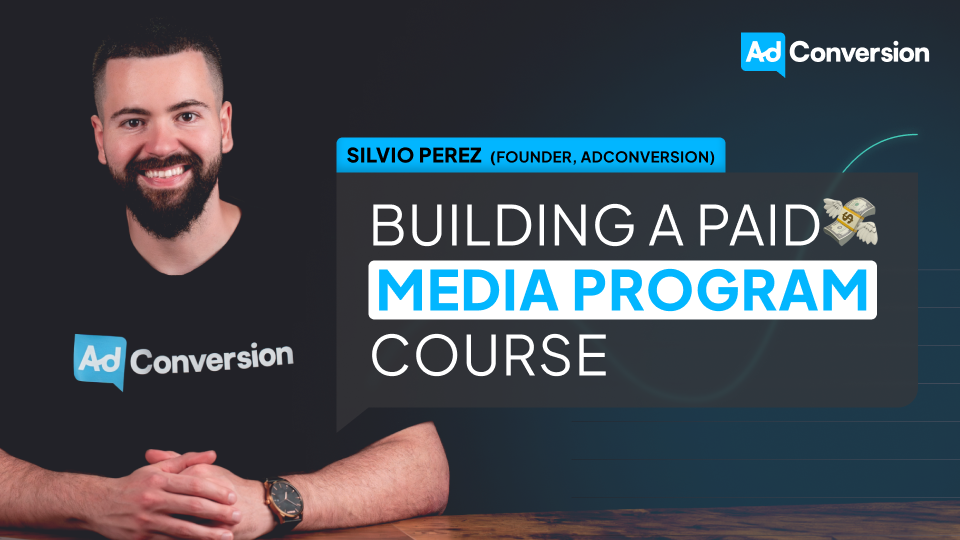
Here’s what is in for you:
- Module 1: you'll learn the S.C.A.L.E framework for building a paid program.
- Module 2: you'll learn how to create your paid strategy with the five stages.
- Module 3: you'll learn how to measure your paid media program correctly.
- Module 4: you'll learn how to create world-class campaigns from A-Z.
- Module 5: you'll learn how to create an experimentation engine.
- Module 6: you'll learn how to scale with the Scaling Quadrant.
It doesn’t matter if you’re a seasoned B2B advertiser or a complete newbie.
You’re going to walk away with frameworks and repeatable processes for building a paid media program that scales.
Click Here to Join 1,000+ B2B Marketers Today and start leveling up your advertising skill set.
It takes < 90 seconds to sign up (seriously we timed it 😂)
People Also Ask
1 - What’s PPC optimization all about?
Think of PPC optimization as fine-tuning your paid ads to get the most bang for your buck. It’s about tweaking keywords, targeting the right B2B audiences, crafting killer ad copy, and making sure your landing pages are on point. The goal? To get your ads in front of the right decision-makers and drive those valuable actions that matter to your business.
2 - How does ad copy make or break a B2B PPC campaign?
Your ad copy is your first impression—so make it count! Speak directly to your audience’s pain points and needs. Highlight what makes you stand out, whether it’s a solution to their problem or something that saves them time and money. Test out different versions (because A/B testing is your best friend) and see what clicks—literally.
3 - Why are landing pages such a big deal in B2B PPC?
Landing pages are where the magic happens. When someone clicks your ad, they expect to land on a page that delivers exactly what was promised. If your landing page is laser-focused, speaks to their needs, and makes it easy to take the next step, your conversion rates will thank you.
4 - What metrics actually matter in B2B PPC campaigns?
In B2B, it’s not just about clicks—it’s about qualified leads and pipeline growth. Watch metrics like CTR, CPC, conversion rate, cost per MQL/SQL, pipeline generated, and ROAS. For Google Search campaigns, don’t ignore quality score. These numbers will tell you if you’re spending wisely or burning budget.
5 - Why is monitoring your B2B PPC campaigns so important?
Things change fast in PPC—your audience, your competition, and even market trends. Keeping a close eye on your campaigns helps you pivot quickly when needed, refine your approach, and keep your ROI looking sharp. Regular check-ins = better results. Simple as that.

10 Techniques You Should Steal From Great B2B Ads
Hey there, B2B marketer! If you're having trouble with high CPLs and low CTRs, bad creatives could be the problem.
In this article, I’ll unpack what great B2B advertising looks like and 10 techniques you can steal from these top B2B ads.
So let’s dive in 👇
TABLE OF CONTENTS
- #1 - Address ICP (Ideal Customer Profile) Needs
- #2 - Clear CTA (Call to Action)
- #3 - Optimized Elements
- #4 - Channel-Savy Ads
- #5 - Direct Language
- #6 - Plain Speak
- #7 - Concise Copy
- #8 - Authentic Imagery
- #9 - Break Norms
- #10 - Build Trust
- Free Resources to Jumpstart Your B2B Marketing Career
1. Address ICP (Ideal Customer Profile) Needs
If you don’t know what your audience cares about, you’ll miss the mark entirely.
The first thing to do is identify the job your customers are hiring your product or service to do so your ads will speak directly to their needs. Because remember, it's not about you. It’s about them.
In the Dooly example below, you can notice within the first five seconds that:
- The ad is talking to sales teams and sales representatives.
- It addresses a major pain point these audiences experience from deeply knowing their audience and having well-defined ad personas.

2. Clear CTA (Call to Action)
Clarity equals high conversions. Your ads need to have a clear call to action that is compelling and stands out in the headline.
Look at the Lusha ad call to action: “Turn prospects into sales faster with Lusha”. Pretty clear!
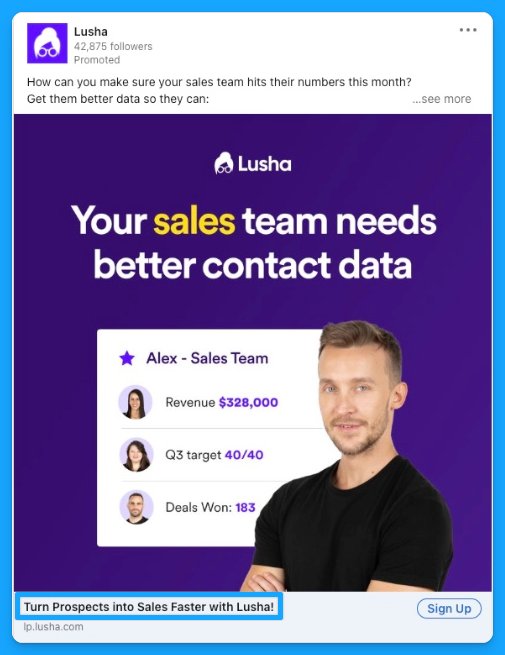
3. Optimized Elements
High-converting ads optimize the elements. They effectively use all the ad components to avoid repetition and tailor the ads to the medium for the most impact, making it easier to convert.
Everyone is busy, and no one wants to waste time. So, by understanding how people use the platform you're advertising on, you can maximize your ad experience and use all the elements meaningfully.
Warning 🚨: When using a lead-gen form or landing page to convert demo requests, make sure the entire experience is as easy as possible to navigate, understand, and convert.
Too often, I’ve seen forms or landing pages that do not match the message in the ad, which is not only confusing but also more challenging to convert.
Here’s a winning example from Zingtree. The goal is to book a demo using a lead gen form:

Why this is a winning ad
- The ad copy clearly states that you can chat with an expert to learn more with a “Learn More” CTA button.
- Matching ad and lead gen form headlines
- Lead gen form copy is clear on what is involved with filling out the form and what will be on the call.
- Lead gen form uses prefilled-in forms as much as possible to decrease the user needing to fill them in – only requiring one form field to be selected.
- The lead gen form confirmation message clearly explains what happens next and points to helpful content.
Where it can improve
- It should say how many business days or hours the team will reach out to schedule the demo
- It could have also pointed to a booking link in the thank you message so leads could automatically book their meeting instead of pointing to content. This helps capture the attention you already have in a more impactful way
4. Channel-Savy Ads
Tailor ads to the medium for impact. “The medium is the message”.
This ad from Cognism is a great example. They repurposed the results from a poll on their organic page comparing their brand with their 2 most significant competitors in EMEA. Genius 😎
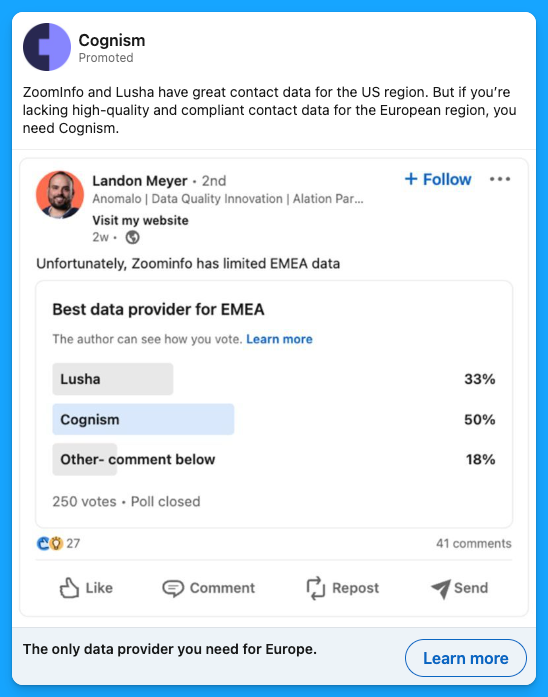
5. Direct Language
Use 'you' and 'your' for engagement.
Let’s not forget that it’s B2B, but we’re still talking to people.
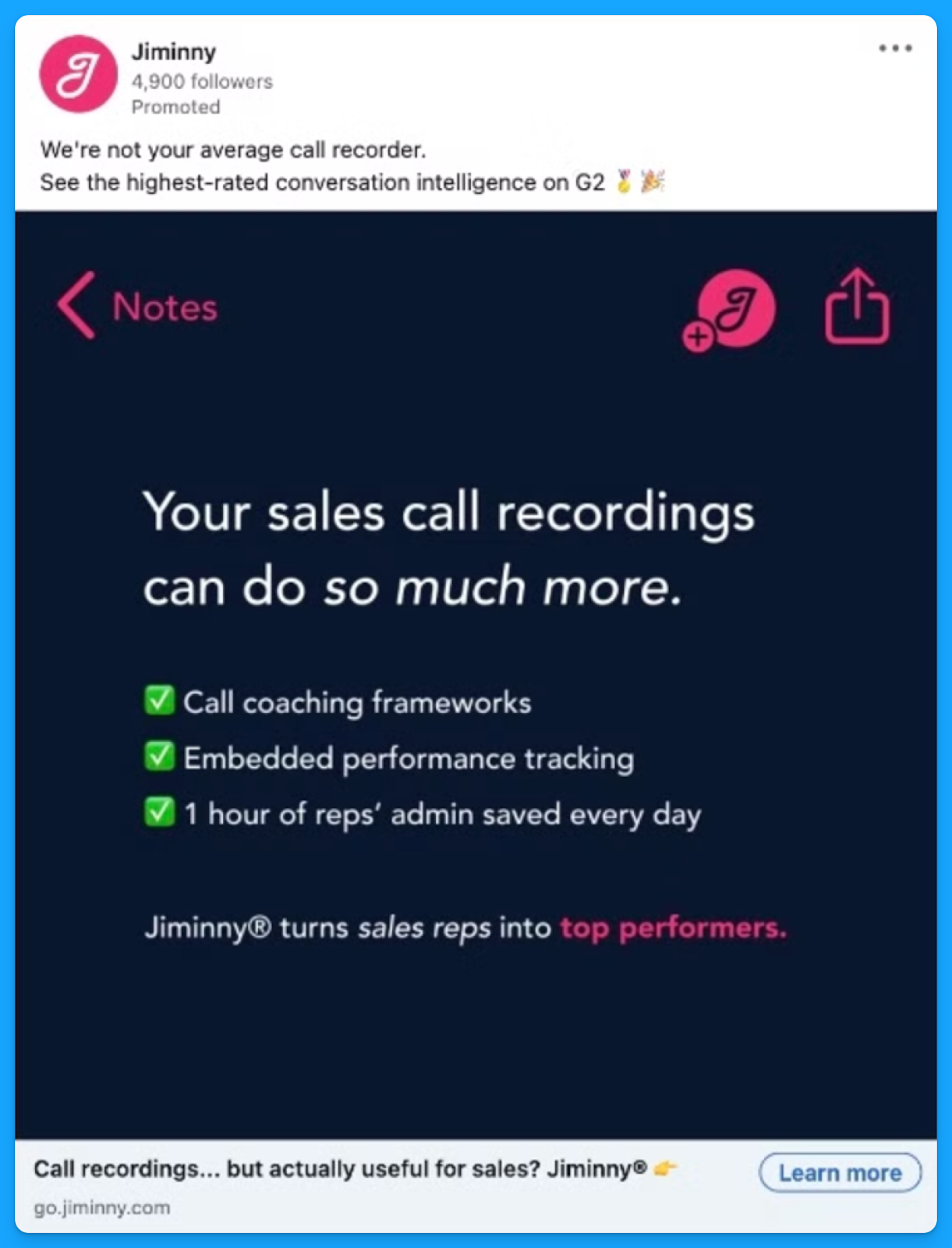
6. Plain Speak
Cut the jargon and use the customer's words in the ads.
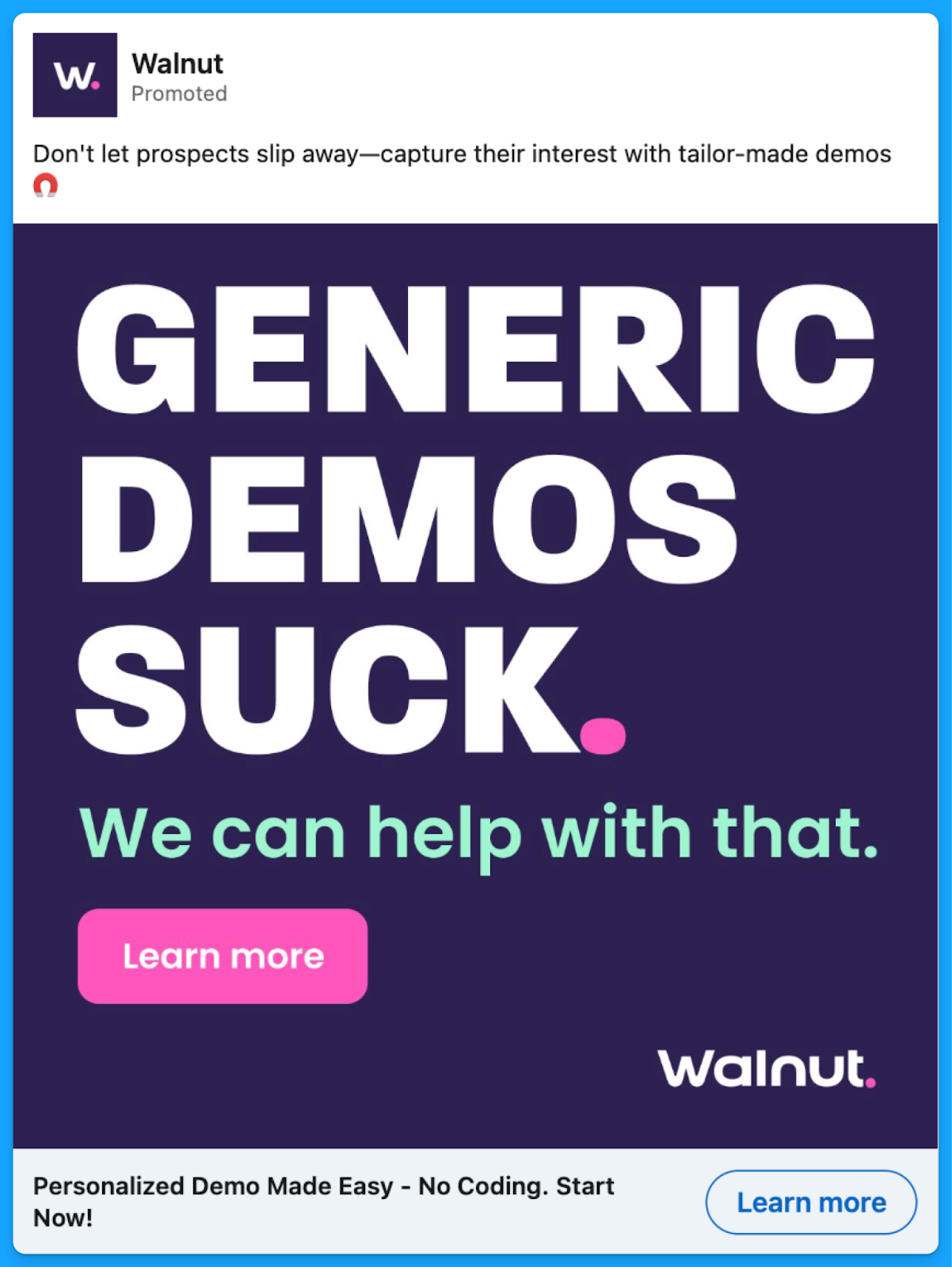
7. Concise Copy
Keep your copy short, ideally between 60 to 120 characters, so it’s easy to consume.Your goal isn’t to explain everything your product does in the ad, it’s to make the prospect take the next step, which could be visiting your website, scheduling a demo, or signing up for a free trial.
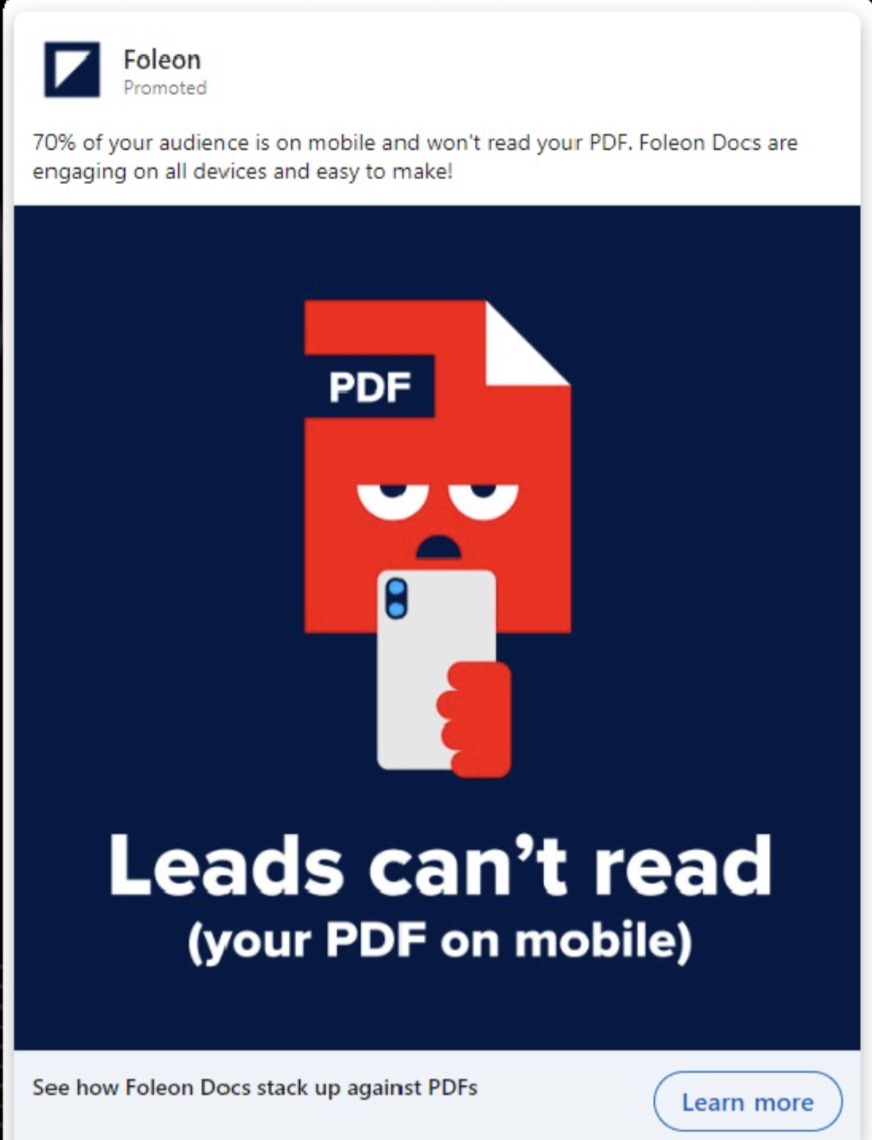
8. Authentic Imagery
Use authentic human images, no stock photos.
There are millions of studies and experiments showing the psychological effect of adding people to the ads (this one from Incivus is a good one), but one of the main reasons is that it connects with the viewer on a human level and builds trust.
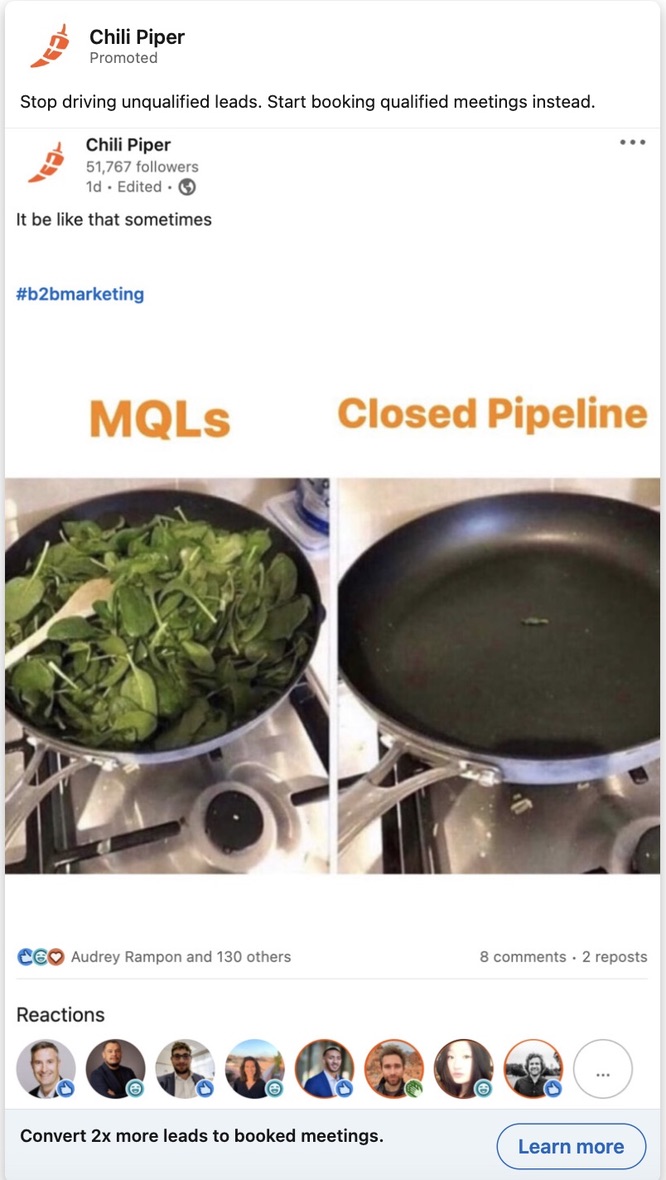
9. Break Norms
Create ads that defy traditional expectations.
This ad from UserGems is pretty cool because it mimics the in-platform alerts to grab the audience's attention and lean into the pain point they were trying to talk about with their ICP.


10. Build Trust
Leveraging social proof and addressing objections early can have a big impact.
Social proof helps build trust, and your prospects will see all the other big brands and competitors using your tool, so it will also give them FOMO (Fear of Missing Out).
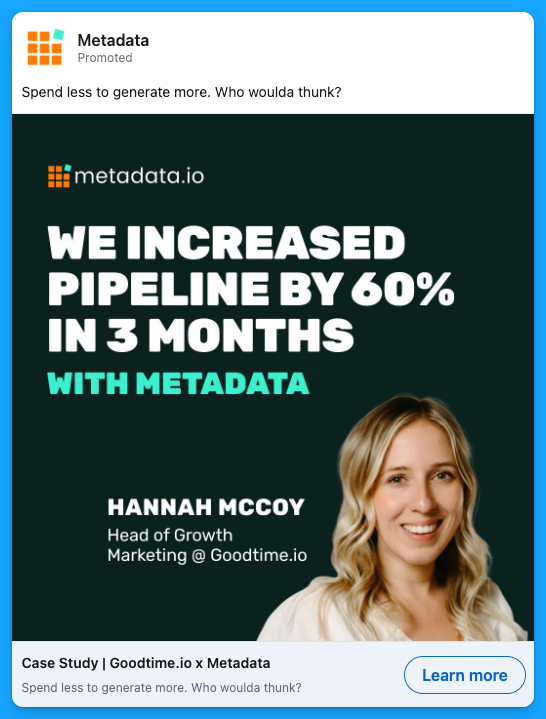
Great B2B ads don’t just happen, they’re built on understanding your audience, removing friction, and breaking the norms.
I hope you found this article helpful!To learn more about B2B ads best practices, dive into the articles below:
Connect with me on LinkedIn, and let’s keep the conversation going.
You can also visit my website here for more valuable content.
Jumpstart Your B2B Marketing Career

If you’re serious about mastering B2B advertising, then you definitely need to check out my free course that will teach you the foundational knowledge to becoming a high-performing B2B marketer who knows how to use advertising to drive legit business and revenue impact without the fluff or wasting your time and money learning the ropes the hard way.
- Module 1: You’ll get a crash course in the B2Bverse and master terminology, sales processes, and working across teams.
- Module 2: You’ll learn how to become your customers' psychologists and understand them deeply through buyer personas that allow you to craft effective messaging.
- Module 3: You’ll master the B2B funnel and learn how to think like a CEO to identify performance bottlenecks and convert more leads into revenue.
- Module 4: You’ll learn how to put it all together and build your go-to-market strategy that gets your ad in front of your dream buyers and converts attention.
This course was designed with absolute beginners in mind.Accelerate your learning curve and start the course today for free.
People Also Ask
How can I effectively measure the success of my B2B ad campaigns?
Utilize key performance indicators (KPIs) such as click-through rates (CTR), conversion rates, and return on investment (ROI) to assess campaign effectiveness. Implement tracking tools like Google Analytics to monitor user engagement and conversions.
What are the best practices for aligning ad creatives with my Ideal Customer Profile (ICP)?
Conduct thorough market research to understand your ICP’s pain points and preferences. Develop ad content that directly addresses these needs, using language and visuals that resonate with your target audience.
How can I ensure my call-to-action (CTA) is compelling and drives conversions?
Craft clear and concise CTAs that communicate the value proposition. Use action-oriented language and place the CTA prominently within the ad to encourage immediate response.
What strategies can I employ to create authentic imagery in my B2B ads?
Use real customer photos or behind-the-scenes images of your team to build trust. Avoid generic stock photos; instead, opt for visuals that genuinely represent your brand and resonate with your audience.
How can I break industry norms in my advertising to stand out without alienating potential clients?
Innovate within the boundaries of your brand identity. Experiment with unique ad formats, storytelling techniques, or humor, ensuring that these elements align with your brand values and appeal to your target audience.
-2.jpg)
Using the Jobs To Be Done Framework to Maximize Revenue in B2B Ads [+Free Template]
Understanding the Jobs To Be Done framework developed by Tony Ulwick can be confusing and overwhelming because most of the information you’ll find is focused on product development.
In this article, I’m going to unpack the Jobs To Be Done framework from a B2B advertising perspective.
Why? Because identifying what job your customers are truly “hiring” your product or service to do will be the secret to launching a powerful ad campaign.
This article is part of our B2B learning track so if you’re serious about learning B2B advertising you’re in the right place!
Let’s dive into it 👏
TABLE OF CONTENTS:
- Understand Why Customers Choose Your Product
- Using the Jobs to Be Done Interview Matrix Template
- Customize Your Messaging with Personality Insights
- Real Use Case of the JBTB Matrix Template
- Free Resources to Jumpstart Your B2B Marketing Career
Understand Why Customers Choose Your Product
In any industry, people don’t buy products, they invest in solutions to get a job done. It’s not just to buy another thing like your cat-hoarding grandmother. 😅🐈

For B2B marketers, Tony Ulwick’s Jobs to Be Done framework should be focused on why your customers “hire” your product or service, so you can put them and their needs at the heart of your advertising story.
This will help you to identify what pain points you’re helping your customers solve to get to the root of what motivates them because your advertising campaign should be about them — not you.
But how can you do that?
You can use the Jobs To Be Done framework when you're launching a new advertising campaign or when you want to improve the conversion rates of your existing advertising campaigns (aka your ads that aren’t converting)
The most impactful way to start is by identifying three to five recent customers who fit your target market (or Ideal Customer Profile - ICP).
If you need help identifying your ideal customer profile, check out this article: “How to Craft B2B Buyer Personas for Ad Targeting”
Select customers who either recently purchased or have the potential to represent your ideal buyer. These interviews will reveal why they chose your service and what specific pain points you helped them solve.
To make your life easier, I developed a free template called Jobs to Be Done Interview Matrix 🙌
You can find it in Module 2, Lesson 3 of my free B2B Advertising Foundations course, and it’s your roadmap for collecting insights during interviews.
Using the Jobs to Be Done Interview Matrix Template to Gather Actionable Insights

In this JTBD Interview Matrix Template, you’ll be looking for five key points that highlight your customer’s journey with your brand:
- Situation and Pain Points - What challenges are they facing?
- Motivation - Why did they start looking for a solution?
- Trigger - What prompted them to move forward with your service?
- Ideal Outcome - What result are they seeking?
- Competitor Evaluation - What other options were they considering?
The matrix helps you organize answers by each customer’s profile and offers a side-by-side comparison of their unique characteristics.
It also offers 8 helpful interview questions you can use to uncover the right golden nuggets that will make your campaign shine. ✨
Customize Your Messaging with Personality Insights
Finally, understanding your customer’s personality type is like having the key to crafting messaging that lands with confidence.
Resources like Crystal can help you determine each customer’s DISC personality type (Dominance, Influence, Steadiness, Compliance) by scraping their LinkedIn profiles, labelling how they like and prefer to be communicated with, and their style and tone because this will ultimately influence the messaging that you can create for each of your advertising personas.

Here’s a real use case for you to understand each step of the JTBD Interview Matrix
Let’s take Spotify as an example. I love Spotify, so if I were doing an interview with a Spotify customer, it would look like this:

Situation & Pain Points
I get tired of hearing the same songs on the radio. I can’t easily listen to the exact song I want to hear.
Motivation
I want to listen to specific songs when I want
Trigger
I’m in the gym, and I need a song to pump me up
Ideal Outcome
I want to listen to the music I choose, everywhere
Other Solutions/ Products Evaluated – Competitors
Radio, XM Radio, Pandora, Apple Music, Silence
Personality characteristics (DiSC type, DiSC archetype, etc)
Trailblazer - ID. Confident style, with a mix of informality and formality gets their attention.
- Pace: Speak slightly fast. Sounds like a ‘gets shit done’ person.
- Tone: Do not sound too eager, as if you have met a friend suddenly after a long time. Keep the tone calm but confident.
- Tactics To Win: Strong words, focus on results, respectful confidence
Based on the JBT Interview Matrix, here are some Spotify ad examples:


The main takeaway is that you can make your ad campaigns even stronger when you really know what “job” your customers are “hiring” your product or service to take care of.
Use the Jobs To Be Done matrix to dig deep into what matters most to them and adjust your messaging to connect on a personal level. 🙂
I hope you found this article helpful!
Connect with me on LinkedIn, and let’s keep the conversation going.
You can also visit my website here for more valuable content.
Jumpstart Your B2B Marketing Career

If you’re serious about mastering B2B advertising, then you definitely need to check out my free course that will teach you the foundational knowledge to becoming a high-performing B2B marketer who knows how to use advertising to drive legit business and revenue impact without the fluff or wasting your time and money learning the ropes the hard way.
- Module 1: you’ll get a crash course in the B2Bverse and master terminology, sales processes, and working across teams.
- Module 2: you’ll learn how to become your customer's psychologist and understand them deeply with buyer personas that allow you to craft effective messaging.
- Module 3: you’ll master the B2B funnel and learn how to think like a CEO to identify performance bottlenecks and convert more leads into revenue.
- Module 4: you’ll learn how to put it all together and build your go-to-market strategy that gets your ad in front of your dream buyers and converts attention.
This course was designed with absolute beginners in mind.
Accelerate your learning curve and start the course today for free.
People Also Ask
How can I effectively identify the ‘jobs’ my B2B customers are trying to accomplish with our product or service?
Conduct in-depth customer interviews and surveys to uncover the underlying tasks and objectives your clients aim to achieve. Focus on understanding their pain points and the desired outcomes they seek. 
What are the best practices for integrating the JTBD framework into our existing B2B advertising strategy?
Align your marketing messages with the specific jobs your customers need to be done. Develop content and campaigns that address these needs directly, demonstrating how your solution effectively fulfills their objectives. 
How can the JTBD framework assist in differentiating our B2B offerings from competitors in the market?
By focusing on the unique jobs your product addresses, you can highlight distinct value propositions that set you apart. This approach shifts the conversation from features to the specific benefits and outcomes your customers can expect. 
What role does customer feedback play in refining our understanding of their jobs to be done?
Regularly gathering and analyzing customer feedback helps in accurately identifying and prioritizing the jobs that need to be done. This ongoing process ensures your offerings remain relevant and effectively meet customer expectations. 
How can we measure the impact of applying the JTBD framework on our B2B advertising ROI?
Track key performance indicators such as conversion rates, customer acquisition costs, and customer satisfaction levels before and after implementing JTBD-informed strategies. Analyzing these metrics will provide insights into the framework’s effectiveness in enhancing your advertising efforts.

B2B vs B2C Advertising: 8 Differences & Examples You Need To Know
Hey there new B2B marketer!
Diving into the world of B2B advertising can be confusing and overwhelming.
In this article I’m going to walk you through 8 differences between B2B & B2C you need to know.
This article is part of our B2B learning track so if you’re serious about learning B2B advertising you’re in the right place!
Let’s dive into it 👏
TABLE OF CONTENTS:
- 8 Biggest Differences Between B2B and B2C
- The Cost of The Product
- How Purchase Decisions Are Made
- The Average Sales Length
- Smaller Audience Sizes
- Different Distribution Strategies
- Need to Support Multiple Sales Funnels
- Team Sport, Not Individual
- Go Further Than Just The First Conversion
8 Biggest Differences Between B2B and B2C
In no particular order of importance, here are the 8 biggest differences between business-to-business (B2B) and business-to-consumer (B2C) advertising.
The Cost of The Product
The first key difference between B2B and B2C is the cost of the product.
B2B marketers call this the average deal size or average contract value depending on what is sold.
Typically, B2B products are more expensive ranging from $1,000 to over $250,000.
How Purchase Decisions Are Made
In B2B buying, there will be more people involved in the purchase of the product compared to B2C where there is usually only one person involved.
This is often referred to as a buying committee, in B2B your job is to nurture, educate, and reach everyone in this group so they can collectively decide to purchase the product.
The Average Sales Length
There are more people involved with purchasing the B2B product or service and the product is typically a more expensive purchase, the length of time to purchase that product is typically longer.
Depending on the complexity of what is being bought, sales cycles can range from 30 days to 36 months. The higher and more complex the product or service is the longer the sales cycle typically is.
This is different from B2C because it can take me 30 seconds to buy something off an Instagram ad.
I’m not sure if that’s a good or bad thing 🤣
Smaller Audience Sizes
With B2B advertising programs, you’ll be targeting smaller audiences across ad channels.
Your audience will typically be less than 300,000 contacts with a focus on reaching the right person and company vs B2C where your audiences will typically be much broader than this since more people can purchase your product or service.
Different Distribution Strategies
Since you’ll be reaching a much more targeted audience, and you may be dealing with a specific budget – the ad channels you decide to use may look different than your B2C advertising counterparts.
It all comes down to where your audience lives and breathes, digitally.
Believe me, I’ve been behind some powerful Facebook ads for B2B. But, you may think twice about using a TV commercial during the Super Bowl as a B2B marketer (well…unless you’re Salesforce!)
But again, this will all depend on your budget and the breath of your buyers.
Need to Support Multiple Sales Funnels
In B2B, your advertising campaigns will support and fuel multiple sales funnels and processes.
The big three are product-lead, sales-lead, and a hybrid of both.
You can learn more about each revenue model in our B2B Advertising Guide.
Team Sport, Not Individual
B2B advertising requires strategic alignment across multiple teams including sales, marketing, and customer success departments to support the buyer’s journey and close deals more effectively.
Given the fact that it’s not just about reaching a specific individual but also a company.
This increases the importance and complexity of working across teams.

Go Further Than Just The First Conversion
The B2B sales processes are more complex and there's more buyers involved.
Your advertising campaigns should be designed to help impact the entire buyer journey.
Not just the first conversion like B2C advertising.

I hope you found this article helpful!
Connect with me on LinkedIn, and let’s keep the conversation going.
You can also visit my website here for more valuable content.
Jumpstart Your B2B Marketing Career

If you’re serious about mastering B2B advertising, then you definitely need to check out my free course that will teach you the foundational knowledge to becoming a high-performing B2B marketer who knows how to use advertising to drive legit business and revenue impact without the fluff or wasting your time and money learning the ropes the hard way.
- Module 1: You’ll get a crash course in the B2Bverse and master terminology, sales processes, and working across teams.
- Module 2: You’ll learn how to become your customers' psychologists and understand them deeply through buyer personas that allow you to craft effective messaging.
- Module 3: You’ll master the B2B funnel and learn how to think like a CEO to identify performance bottlenecks and convert more leads into revenue.
- Module 4: You’ll learn how to put it all together and build your go-to-market strategy that gets your ad in front of your dream buyers and converts attention.
This course was designed with absolute beginners in mind.
Accelerate your learning curve and start the course today for free.
People Also Ask
How do customer expectations differ between B2B and B2C markets?
B2B customers typically expect detailed information, personalized communication, and long-term value, focusing on how a product or service can address specific business needs. In contrast, B2C customers often seek quick solutions, emotional satisfaction, and immediate benefits, valuing convenience and brand experience.
What are the implications of these differences for customer service strategies?
In B2B markets, customer service should be consultative, offering tailored solutions and ongoing support to build strong relationships. For B2C markets, customer service should prioritize efficiency, accessibility, and positive experiences to foster customer loyalty and satisfaction.
How do pricing strategies vary between B2B and B2C businesses?
B2B pricing often involves negotiation, volume discounts, and customized quotes based on the client’s specific requirements. B2C pricing is generally fixed, with occasional promotions or discounts aimed at attracting a broad consumer base.
What role does branding play in B2B versus B2C marketing?
In B2B marketing, branding establishes credibility and trust, positioning the company as a reliable partner. In B2C marketing, branding focuses on creating an emotional connection and brand loyalty among consumers.
How do digital marketing strategies differ between B2B and B2C companies?
B2B digital marketing often leverages content marketing, LinkedIn outreach, and email campaigns targeting decision-makers. B2C digital marketing utilizes social media platforms, influencer partnerships, and broad-reaching advertising to engage consumers.
.png)
How to Craft B2B Buyer Personas For Ad Targeting
Hey there B2B marketing grasshopper 👋
In this article, we're channeling our inner Mr. Miyagi from "The Karate Kid," because we're about to master the art of creating B2B buyer personas.
Wax on, wax off style – but with less wax and more wisdom!
Let’s dive into it.
TABLE OF CONTENTS:
- What Is a B2B Buyer Persona?
- 3 Major B2B Marketing Personas
- How to Develop a B2B Buyer Persona
- The Five B2B Buyer Persona Segmentations
- B2B Buyer Persona Template
- Translating B2B Buyer Persona’s into Ad Targeting
What Is a B2B Buyer Persona?
Just like Daniel-san needed to understand his opponents in the All Valley Karate Tournament, it's important to understand your B2B buyer personas to win in the market.
It's critical because these personas are your roadmap – they guide every marketing punch and kick you make.
If you don’t do this, your marketing efforts might be as off-target as Daniel-san trying to catch a fly with chopsticks on his first try.

We're talking about misdirected resources and messaging that misses the mark, leaving your ROI down and out — so let's break it down, Karate Kid style:
What is a persona? It’s the semi-fictional characters that make up your target audience. It’s a great way to unpack who makes up your ideal customer profiles, called an “ICP”
3 Major B2B Marketing Personas
In B2B marketing there are 3 major personas or roles to understand in the sales process.
This is also referred to as a buying committee:
- Decision Maker – The person who makes the final decision to purchase
- Champion - A person who enthusiastically supports your product or service in their organization
- Influencer - A person who can influence other members of the buying committee

Your marketing and advertising efforts should address their needs and concerns when it comes to buying and using your product or service.
Knowing what these personas are looking for will help you tailor your messaging to make your ads stand out.
For example: imagine your buyer persona 'Finance-Manager-Frank'. He's in his mid-40s, loves numbers more than karate, and is always on the lookout for tools that bring efficiency and balance. Where does he find his information? → LinkedIn and financial blogs
Knowing this, you’d be able to hone in your advertising strategy to use LinkedIn ads to demonstrate how finance managers find more efficiency from their investments by using your product.
How to Develop a B2B Buyer Persona
There’s 5 major segmentation buckets to consider when putting together a B2B buyer persona:
- Demographic Segmentation
- Targeting potential customer based on their role (ex: Job Titles, Job Functions)
- Firmographic Segmentation
- Targeting potential customers based on company traits (ex: Industry, Company Size)
- Geographic Segmentation
- Targeting potential customers based on their company and physical location (ex:USA)
- Technographic Segmentation
- Targeting potential customers based on the tech they use (ex: Slack, Teams)
- Behavioral Segmentation
- Fine tune your messaging based on your potential customers Jobs To Be Done, decision-making process, and more.
Within each segmentation, there’s key information you should collect to build your personas which will ultimately inform your advertising channel strategy, targeting, and messaging.
Getting crystal clear on your buyer personas will also help you maximize your resources, build internal trust with your sales and service teams, and drive better results.
Let’s dive into the five segmentations in greater detail.
The Five B2B Buyer Persona Segmentations:
Demographic
Target potential customer based on their role
- Role: Identify the job title and role they’re in and what level in their organizations they fall (individual contributor, middle management, or in the C-suite – chief roles including CEO, CFO, CMO, etc).
- Responsibilities: Identify all the key areas they oversee and manage. Pulls who they report to.
Firmographic
Target potential customers based on company traits
- Company Industry: ex: Technology, Manufacturing
- Company Employee Size: ex: 500 - 1,000 employees
- Company Revenue Size: $1,000,000 - $10,000,000 ARR
Geographic
Target potential customers based on their company and physical location
- Company Location: ex: United States, Canada
- Employee Location: ex: United Kingdom
Technographic
Target potential customers based on the tech they use
- Tools: This breaks down the tools they use or need to do their jobs (ex: Slack, Teams)
- Company Competitors: list out any relevant competing technologies
Behavioral
Fine tune your messaging based on your potential customers Jobs To Be Done, decision-making process, and more.
- Goals: This details how their job is measured by
- Jobs to be Done/Pain Points: This elaborates on the biggest challenges they face in their role
- Decision-Making Process: This goes into detail on who they need approval from when buying a new product/service, who signs the contract, who owns the budget
- Evaluation Process: This details how this persona typically decides on a product
- Objections & Concerns: this outlines what prevents them from making a decision
- Consumption Habits: how do they gain information for their job and what social media networks do they use
B2B Buyer Persona Template
To help you put this into action get a free copy of my B2B Buyer Persona template in Module 2 - Lesson 2 of my B2B Advertising Foundations Course when you sign up for free. With this template you will be able to easily map out your buyer persona across the five segmentations.

Translating B2B Buyer Persona’s into Ad Targeting
After completing the B2B Buyer Persona template you should be very clear on who you’re going after.
Now you’ll want to review your persona’s segmentation and find possible targeting opportunities in the platforms you’re considering advertising on – your options will vary greatly by channel.
Create a draft campaign in your ad platform of choice and review all of the audience targeting options available – sometimes you’ll need to get creative! (example below of LinkedIn Ads).

And that my advertising friends is your way to craft a buyer persona you can use to identify the audiences you’ll be targeting in your B2B advertising.
Hope you found this article useful!
Connect with me on LinkedIn, and let’s keep the conversation going.
You can also visit my website here for more valuable content.
Jumpstart Your B2B Marketing Career

If you’re serious about mastering B2B advertising, then you definitely need to check out my free course that will teach you the foundational knowledge to becoming a high-performing B2B marketer who knows how to use advertising to drive legit business and revenue impact without the fluff or wasting your time and money learning the ropes the hard way.
- Module 1: You’ll get a crash course in the B2Bverse and master terminology, sales processes, and working across teams.
- Module 2: You’ll learn how to become your customers' psychologists and understand them deeply through buyer personas that allow you to craft effective messaging.
- Module 3: You’ll master the B2B funnel and learn how to think like a CEO to identify performance bottlenecks and convert more leads into revenue.
- Module 4: You’ll learn how to put it all together and build your go-to-market strategy that gets your ad in front of your dream buyers and converts attention.
This course was designed with absolute beginners in mind.
Accelerate your learning curve and start the course today for free.
People Also Ask
How can I ensure my B2B buyer personas remain accurate and relevant over time?
Regularly update your personas by conducting periodic market research and gathering feedback from sales and customer service teams. This ensures they reflect current market conditions and evolving customer needs.
What are effective methods for validating the assumptions made during persona development?
Validate assumptions by analyzing customer data, conducting interviews, and implementing surveys. Cross-referencing these insights with your personas helps confirm their accuracy.
How can I align my sales and marketing teams using B2B buyer personas?
Facilitate workshops and regular meetings to discuss and refine personas, ensuring both teams have a shared understanding of target customers. This alignment fosters cohesive strategies and messaging.
What role do negative personas play in refining marketing strategies?
Negative personas represent segments that are unlikely to convert. Identifying them helps in excluding these groups from marketing efforts, thereby improving resource allocation and campaign efficiency.
How can I leverage B2B buyer personas to enhance content marketing efforts?
Use personas to tailor content that addresses specific pain points and interests of each segment, thereby increasing engagement and conversion rates.

Join 0,000 B2B marketers leveling up their paid advertising skill set! 🚀
Join 0,000 B2B marketers leveling up their paid advertising skill set! 🚀








%20-%20new%20v2.png)

